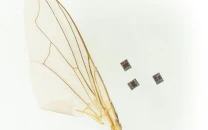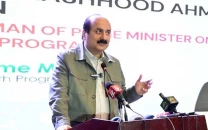'10 steps ahead': Kenya's tech war on wildlife poachers
Ol Pejeta launched what it calls the world's first wildlife tech lab

A warden guards Sudan, the last surviving male northern white rhino, at the Ol Pejeta Conservancy in Laikipia national park, Kenya May 3, 2017.
PHOTO:REUTERS
It's an antiquated approach to outsmarting would-be hunters, but this ranger is not alone. High on a mast nearby, a new camera scans around the clock for intrusions, relaying real-time images to armed guards at park headquarters.
It is among the latest technology deployed to combat poaching at Ol Pejeta, a private conservancy on Kenya's Laikipia plateau that shelters the only two northern white rhinos left on earth, among other endangered giants.
World's last male northern white rhino euthanised in Kenya
A handful of surveillance cameras may not seem very sophisticated for a sanctuary which is also home to the largest population of critically endangered black rhinos anywhere in East Africa.
But it's just the tip of the spear.
Last month, Ol Pejeta launched what it calls the world's first wildlife tech lab -- a research hub at the heart of the sanctuary dedicated to bringing conservation management into the information age.
Inside a retrofitted shipping container, computer engineers are testing the next generation of animal tracking chips and developing remote sensors that could one day monitor everything from ranger health to river levels.
"We are very much in our infancy when it comes to this kind of stuff. It is pretty cutting-edge from a conservation perspective," Richard Vigne, the chief executive of Ol Pejeta, told AFP.
Only surviving male northern white rhino put under armed guard
Among other projects, researchers are working towards a chip small enough to fit in a rhino horn, but capable of live transmission of the animals' exact location and core vitals.
"No one else in the conservation space in Kenya is testing this... For me, that was very exciting," said Damian Otieno, a Kenyan IT engineer who left an office job for a career in conservation tech, and now leads the Ol Pejeta initiative.



















COMMENTS
Comments are moderated and generally will be posted if they are on-topic and not abusive.
For more information, please see our Comments FAQ